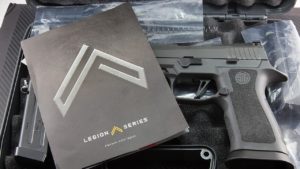 Ah, the lure of a heavy pistol for practical pistol competition. It’s the reason why metal frame guns like the CZ Shawdow 2 and the 2011 platform have become such a dominant force in practical shooting, and are generally preferred over lighter polymer framed striker fired pistols. The reasoning behind this comes down to simply physics: the mechanical advantage provided by metal framed guns provides greater recoil mitigation. Less recoil means less interruption of the sight picture between shots, and that translates to greater speed and accuracy. Metal framed guns however have historically brought with them some negative consequences which striker fired polymer handguns don’t have. For DA/SA metal framed guns, you have to accept that longer, heavier first pull of the trigger…and in some cases added controls like a decocker and/or safety. 2011’s on the other hand are generally SAO in operation, but also have a safety to contend with, and can not only be less reliable then their striker fired counterparts, but also orders of magnitude more expensive than striker fired polymer guns. Walther attempted to bring the best of both of these worlds together in a single firearm in late 2018 with the release of their Q5 Match SF – a steel frame striker fired competition pistol. I got hands on with this gun earlier this year at the 2019 NRA Annual Meeting:
Ah, the lure of a heavy pistol for practical pistol competition. It’s the reason why metal frame guns like the CZ Shawdow 2 and the 2011 platform have become such a dominant force in practical shooting, and are generally preferred over lighter polymer framed striker fired pistols. The reasoning behind this comes down to simply physics: the mechanical advantage provided by metal framed guns provides greater recoil mitigation. Less recoil means less interruption of the sight picture between shots, and that translates to greater speed and accuracy. Metal framed guns however have historically brought with them some negative consequences which striker fired polymer handguns don’t have. For DA/SA metal framed guns, you have to accept that longer, heavier first pull of the trigger…and in some cases added controls like a decocker and/or safety. 2011’s on the other hand are generally SAO in operation, but also have a safety to contend with, and can not only be less reliable then their striker fired counterparts, but also orders of magnitude more expensive than striker fired polymer guns. Walther attempted to bring the best of both of these worlds together in a single firearm in late 2018 with the release of their Q5 Match SF – a steel frame striker fired competition pistol. I got hands on with this gun earlier this year at the 2019 NRA Annual Meeting:
Nice gun to be sure – but with a ~$1400.00 price point, the platform seems to mainly appeal to the Walther purists – there hasn’t been a huge jump to platform adoption since its release. Fast-forward to May 2019, and SIG Sauer announces it’s very own solution to the problem of enjoying the benefits of an all-metal gun AND a striker fired polymer gun – the SIG P320 X-Five Legion.
I was one of the first individuals in the US to receive and evaluate the P320 X-Five in April of 2017, and have been shooting it exclusively in USPSA, Steel Challenge, and 3-Gun. As such I’m uniquely qualified to evaluate the Legion X-Five against not only other options in the marketplace, but also relative to the non-Legion X-Five. Prior to the Legion X-Five, I was already well convinced that the P320 X-Five was one of the the best options for a competition handgun. Notice I didn’t qualify that by saying “best striker fired handgun” or best “polymer handgun.” If you think that’s some sort of SIG fanboy bias on my part, just check out the equipment survey results which USPSA published in the Annual issue published earlier this year:
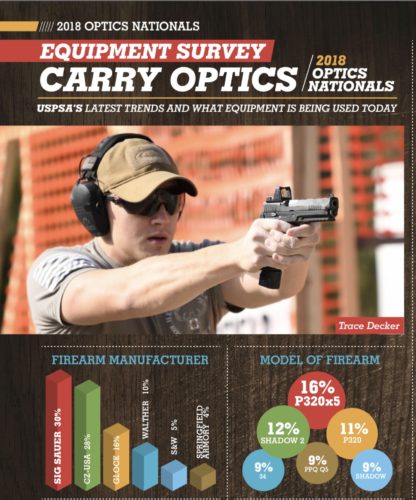
The X-Five dominated the USPSA Carry Optics division (my pistol division of choice) at the 2018 Nationals, with SIG P320 based guns making up over 25% of the division. I’ve auditioned other options incuding the CZ Shadow 2 and the venerable 2011, and while I realize I’m in the minority on this one, I actually prefer the X-Five over a metal frame gun. I don’t mind paying for performance, but paying for more potential headaches just isn’t easy to justify. A 2011 is a a $3000.00 plus option (plus those wonderful $100.00+ magazines that require regular “tuning” to run reliably. A Shadow 2 is less expensive, but has it’s own requirements to run reliably (change those springs on the regular…). Additionally, as a CCW holder an X-Five is also a LOT closer in form and function to the polymer striker fired guns the vast majority of CCW holders use as a tool for self-defense (myself included), which I see as a strong consideration when choosing a competition firearm. I’m not an engineer or a mechanic and I don’t like the thoughts of a gun which I have to “fiddle” with to keep them running. My X-Fives just run – as a result my competition game has steadily improved since the X-Five debuted. But as good as the P320 X-Five is, could it be made better? The Legion X-Five certainly attempts to answer that question.
THE LEGION CONCEPT
As significant as the upgrades to the P320-X-Five are, I think it’s important to first examine the concept behind SIG’s Legion sub-brand, and the signficance of the newest addition to the Legion line.
The SIG Legion program came to life in 2015. It’s a club. It’s a VIP program. It’s also the ulmiate version of any SIG pistol which has been given the Legion treatment. It’s a great concept, and secretly I’ve been a little envious of those “Legionnaires” that were already “in the club. Some consider the Legion line an expensive “gimmick” but the reality is that if you try to duplicate the enhancements and upgrades SIG does to the various Legion pistols, you can’t make your own Legion version of a SIG Legion pistol at the price they sell it – it’s a bargain. Up to this point, only SIG classic line firearms had been given the Legion treatment. I’ve already got a couple of SIG P226’s in my safe that don’t get shot nearly enough and haven’t felt the need to run out and get a Legion P226. What I REALLY wanted was a Legion version of the P320 line – which SIG has now finally provided. The Legion P320 X-Five is the first P320 to be inducted into the Legion line, and I’m sure it won’t be the last.
The first and most obvious difference in the Legion X-Five from previous versions is the color. As much as I like the Legion concept, the Legion gray PVD coating/color has never really been my personal cup o’ tea. That said, I was pleasantly surprised when I opened the box and saw mine for the first time. It’s not bad…but my personal preference would be for black.
The second (and perhaps the most significant change) is the overall weight of the gun. SIG found a way to infuse tungsten into the composition of the X-Five polymer grip module, which is as impressive as it is innovative. That brings the weight of the gun up to 43.5 oz. (per SIG), up from 35.6 oz. in the non-Legion X-Five. That weight number is not mere happenstance by the way. The USPSA weight limit for the Carry Optics division is 45oz., including the optic and an empty magazine. So the Legion X-Five really can’t get much heavier and be legal for Carry Optics. Understand, the Legion X-Five wasn’t just designed for “competitive shooting.” It was specifically designed for use in USPSA (and by extension, Steel Challenge) where the X-Five is already, as demonstrated above, one of the most popular choices for the USPSA Carry Optics division. I’ve been reading about and watching some initial videos on the Legion X-Five, and it’s obvious that many (if not most) reviewers just don’t quite grasp this fact (more on that later). I’ve also seen other reviewers criticize the fact that the Legion X-Five comes with 17-round magazines and not 21 round magazines which come with the non-Legion X-Five. Again, this is what happens when gun writers and YouTubers who don’t shoot competitively try and review a competition specific firearm. Again, the Legion X-Five was made for USPSA and Steel Challenge competition specifically. The stock SIG P320 21-round magazine slightly exceeds the magazine length requirements for USPSA. Most competitors (like myself) end up buying 17-round magazines, and fitting them with base plates which expand their capacity to 22 rounds. So the true USPSA competitors who buy this gun will be pleased with the included 17-round magazines, though they may not use the included Henning base plates marked with the Legion logo, nifty though they may be.
If a heavy gun is important, then SIG had theoretically nullified the main advantage which metal framed guns previously had – it’s as heavy if not heavier than any other firearm used in similar divisions within USPSA. When I picked up the Legion for the first time, I was struck by how different the grip felt from any other gun. The grip doesn’t exactly feel like metal, but neither does it feel like a polymer grip. It’s…something else. It also has an added quality feel that’s similar to metal guns that goes behind the weight. It just feels…nicer.
If you’ve been reading press releases and watching videos about the new Legion X-Five, you might think at the color and the weight are really all that’s different or improved. Nope. The biggest improvement is actually the price – or more specifically how ready out of the box for competition the Legion X-Five really is. In fact, I would submit that the Legion X-Five is actually cheaper than than the non-Legion X-Five. “But Joooohn….the retail price of the Legion X-Five is $100.00 more than the non-Legion.” That’s true. If your purpose for buying the gun is to stick it in a gun safe, then yes you’ll pay about $100.00 more for the Legion X-Five. But most buyers of the X-Five acquire the gun for use in competition, so let’s compare the real and true costs associated with competing with an X-Five vs. the Legion X-Five:
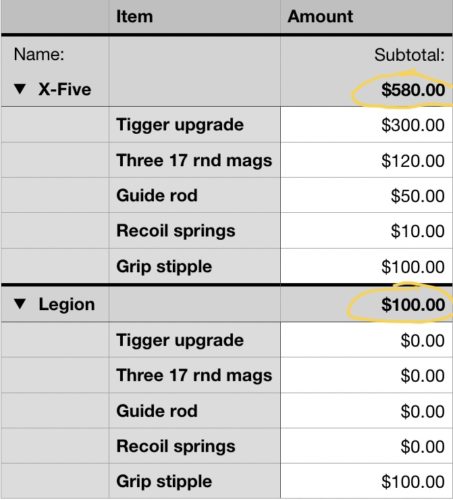
Above are listed what I consider to be essential upgrades of the SIG P-320 X-Five to make it truly competitive including the Grayguns Competition Trigger Kit, three 17-round magazines (that when combined with your choice of base plates, takes magazine capacity to 22-23 rounds), a 1911-style guide rod (adds weight and allows the use of reduced recoil springs), and a replacement recoil spring. These upgrades add nearly $600.00 to the cost of the non-Legion X-Five. By comparison, the Legion X-Five comes with the guide rod, recoil springs, and three 17-round magazines! Additionally, SIG has improved the Legion X-Five trigger to give it nearly identical performance characteristics to the Grayguns Competition Trigger! So in my book, the Legion doesn’t cost $100.00 more than the non-Legion X-Five…it costs nearly $500.00 less.
The on;y upgrade the Legion X-Five truly needs to be competition ready is the grip texture, which is essentially the same as the non-Legion. Because the Legion X-Five grip module is tungsten infused polymer, it can still be stippled just like traditional polymer. The grip modifications available to polymer grips is far more customizable than a metal framed gun.
HOW IS THE TRIGGER?
The trigger on the Legion X-Five is a definite upgrade from the non-Legion X-Five, both in feel and in pull weight. Here’s a photo of the trigger pull weight of the original SIG P320 X-Five I reviewed back in April of 2017:
Now Here’s a photo of the Legion P320 X-Five:
Out of the box, they shaved over 2 lbs. off the trigger – that’s a huge improvement. Now here’s a photo of the non-Legion P320 X-Five with a Greyguns Competition Trigger installed:
You may conclude that the lower trigger pull weight of the Grayguns Competition Trigger in the non-Legion P320 X-Five makes it a better choice over the Legion trigger, and that would be a mistake. When I first installed the Graguns Competition Trigger in my X-Five, the pull weight was pretty close to what we see with the Legion. Over the course of shooting about 5,000 rounds through the gun in the last year, the weight has dropped significantly. You’ve heard of “polishing” a trigger to make it smoother and reduce the pull weight? Putting a lot of rounds down range and doing a lot of dry fire trigger pulls accomplishes the same result – a lighter, smoother trigger. I think the Legion X-Five trigger is darn close to where the Grayguns trigger breaks and resets, and I believe the weight will drop significantly with wear, just like the Grayguns trigger. I would also point out that, out of the box, my shooting performance wasn’t noticably dimished by the slightly heavier trigger on the Legion as can be seen in the below video.

I compared my non-Legion P320 X-Five with stippled grip and Gray Guns Trigger to the Legion X-Five on the range.
HOW DOES IT SHOOT?
Having been an X-Five shooter since before the gun was released to the public, I was more than anxious to see not only how the Legion X-Five performed on the range, but also to compare it to the non-Legion X-Five – of which I have two. I took the Legion X-Five and one of my non-Legion X-Five pistols out and ran about 300 rounds through each performing a variety of drills (again which you can see in the below video).
I think a lot of people feel a heavier gun, feel how softly the guns shoots, and they think it must make a substantial difference downrange. In fact, several of people have questioned me on my choice to shoot an X-Five in competiton. “You would shoot SOOOO much better with a heavy gun.” I’ve always suspected this was more about people trying to justy the purchase of the Shadow 2 or 2011, and I never thought making that switch would be a signifant improvement to my own shooting performance. To test this for myself, I took my non-Legion and my Legion X-Five out to the range to shoot some drills. To keep things as fair as possible, I put a non-Legion slide on my Legion grip module which allowed me to be able to use the Romeo 1 6moa optics I had on hand for both versions of the X-Five. The Legion X-Five slide is cut to accommodate a Romeo 1 Pro (not out on the market yet) or a Leupold Delta Point Pro. Not having either of these readily available, my solution allowed for more of a direct comparison. Both versions of the X-Five also had the same Springer Precision tungsten guide rod, and 13lb recoil spring. The only substantive difference between the two versions of the X-Five I tested was grip texture. As it was a mild mid-70 degree afternoon with low-humidity, I honestly don’t believe the difference in grip texture was a significant factor. The testing revealed the following:
-My performance on the drills I ran was remarkably similar using both versions of the X-Five. There was no significant difference in the speed at which I was able to perform the drills, but I was pretty consistently more accurate with tighter groups using the Legion X-Five
-The heavier gun did not deter my performance in any way. I have often seen it speculated in online discussions that a heavier firearm would result in a slower draw or even slower transitions between targets. Again, my speed was nearly identical with both guns.
When I moved to the plate rack, I did enjoy some substantial improvements when using the Legion X-Five. My performance was both more repeatable and faster. Here’s my best run using the non-Legion X-Five:
Here’s two back-to-back runs with the Legion X-Five:
The plate rack at my home range had only 5 working plates that day. But you can extrapolate what my time would have been on six plates using the last recorded split time that is visable on the timer:
Non-Legion run: 3.15 +.35=3.50 seconds for six plates
3.50 is about normal when I practice on the plate rack. For reference, my best ever time on a six-plate drill is 3.23 seconds. Now let’s look at the two runs I got with the Legion X-Five:
1st Legion run: 2.87+.36=3.23 seconds for six plates
2nd Legion run: 2.80+.34=3.14 seconds for six plates
The first Legion run actually tied my personal best plate rack time, and my second run with the Legion X-Five would have handily beat my personal best and (in theory) become a new record for me. So as much as I think I’ll enjoy some benefits with the Legion X-Five in USPSA, I’m even more excited to see how I will perform with it in Steel Challenge. But the bottom line here is that the difference in weight did seem to improve my shooting performance, but not in a hugely significant way – only training and hard work will do that. Would switching to the Legion X-Five move me up in classification in USPSA or Steel Challenge? No. Might it make the difference between 1st or 2nd place in my division at a match? Yes, I think it might.
As mentioned above, I recorded a video supplement to my written photo review for the ThruMyLens YouTube Channel, complete with footage from the range testing I did:
The SIG Sauer Legion X-Five is a huge win for the competitive shooting community. We finally have a firearm that combines the performance and handling characteristics of a metal framed gun, with the benefits and reliability associated in a polymer framed, striker fired gun. And we have it at an extremely affordable price point – well below all the metal framed competitors this firearm challenges. It feels incredible to shoot, and brings with it some real improvements in shooting performance. Long live the Legion.

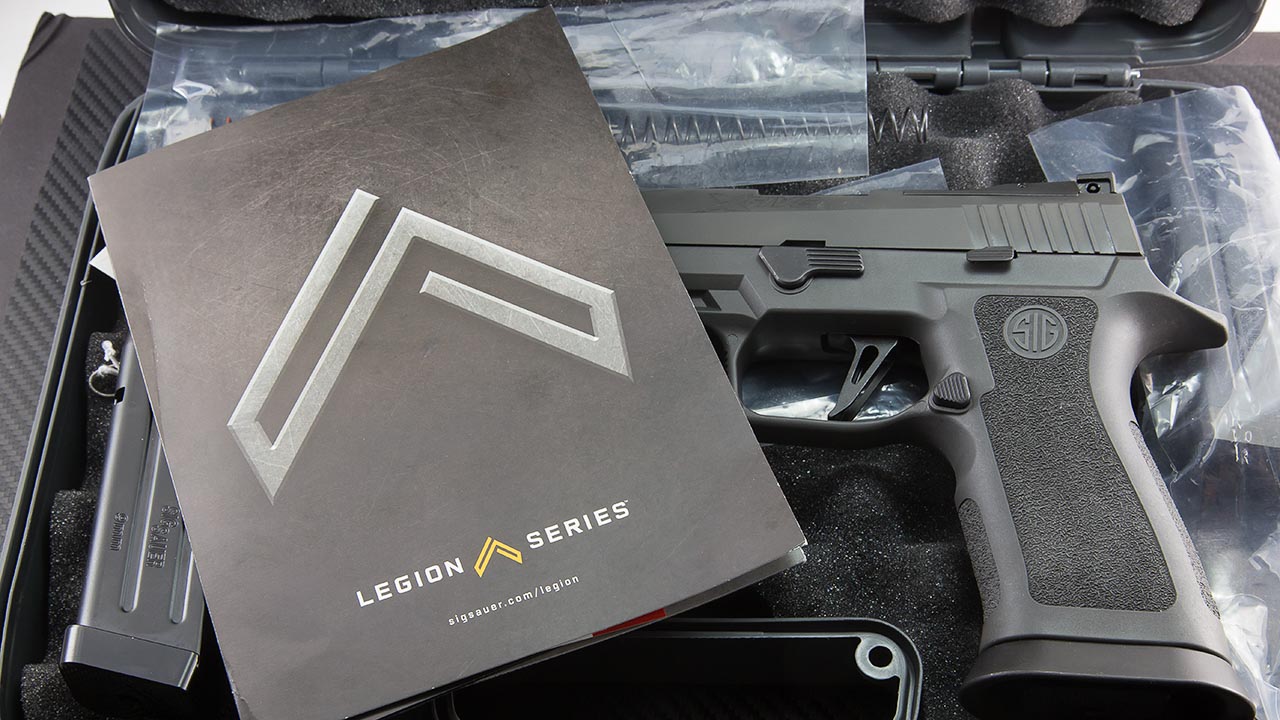
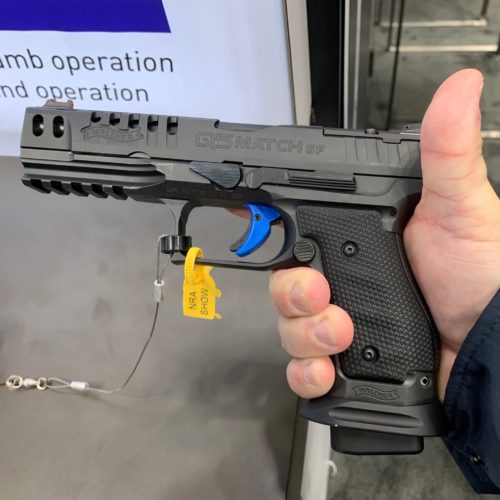
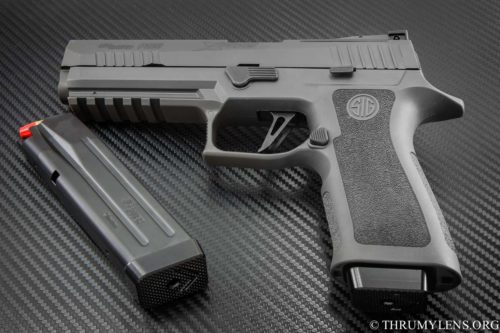
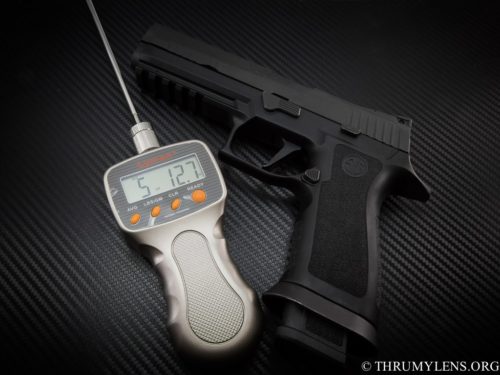
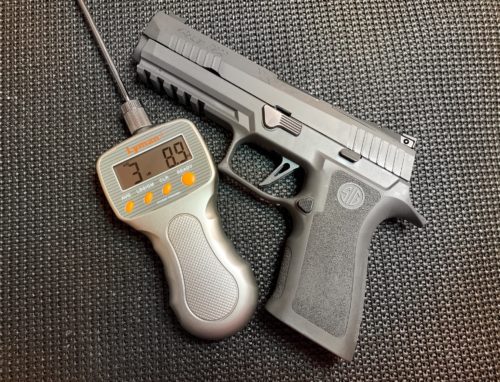
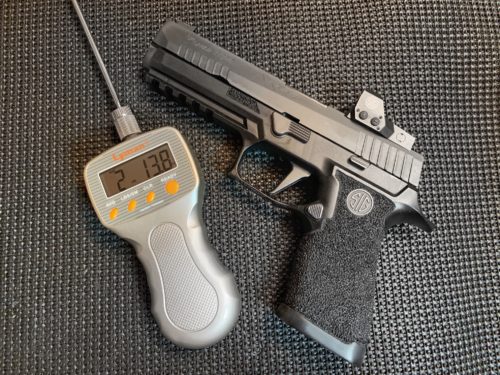
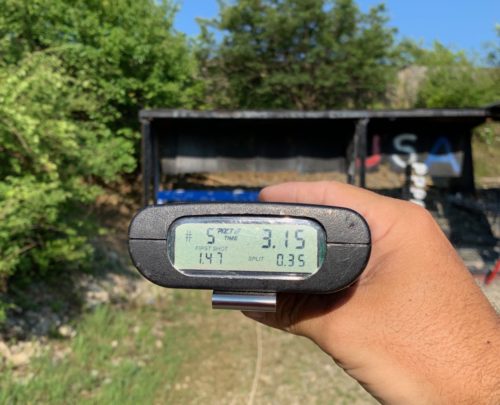
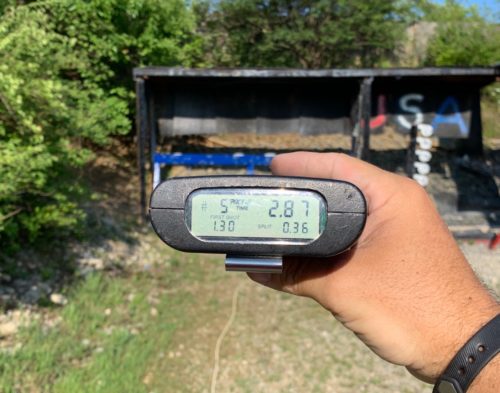
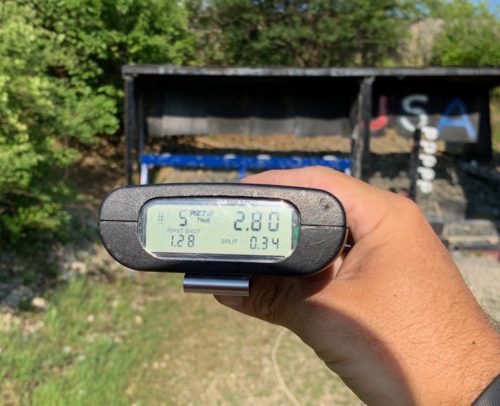
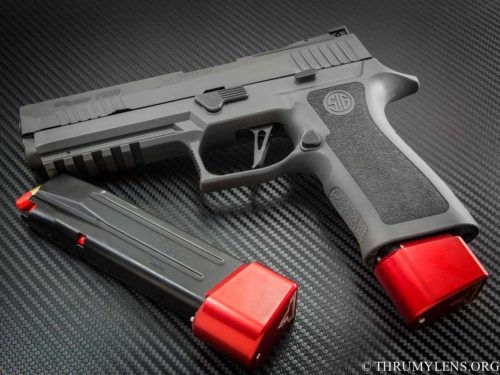
0 Comments